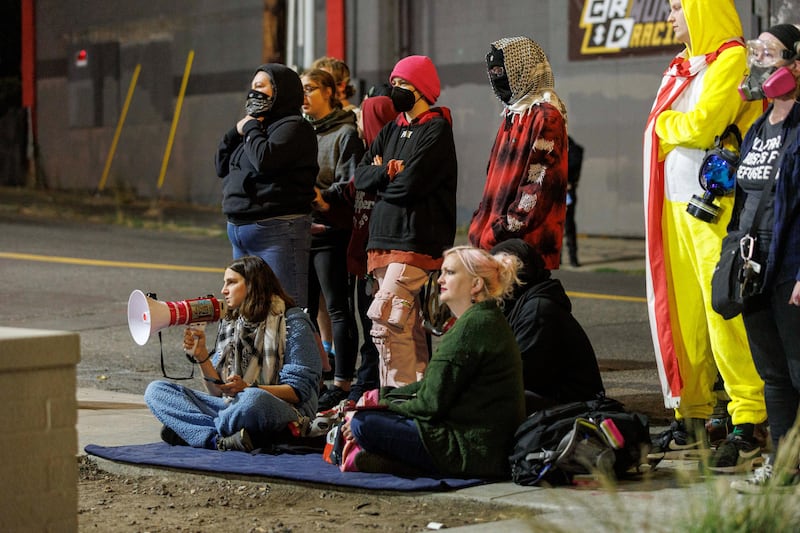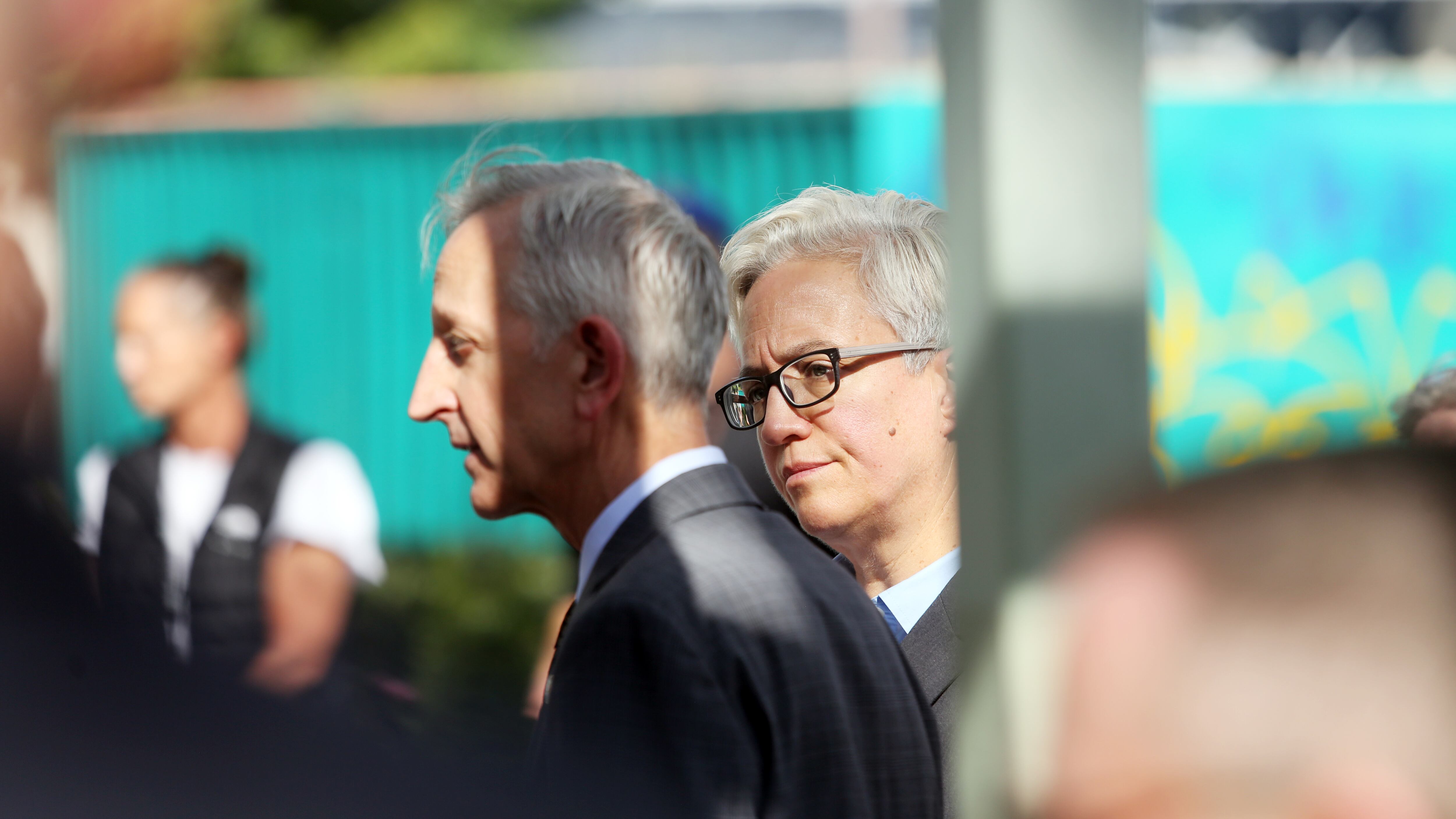This past Saturday, Gov. Tina Kotek tried to dissuade President Donald Trump from launching a military mission into Portland based on a perception of the city that, by his own account, had been informed by a television segment.
In a press conference staged on the banks of the Willamette River, Kotek recalled telling Trump that his impression did not reflect the reality on the ground. “He thinks there are elements here that are creating an insurrection,” Kotek said, referring to the nightly protests 2 miles south at the U.S. Immigration and Customs Enforcement facility. “I told him there is no insurrection here, and that we have this under control.”
She was not the only Oregonian making such a case to outsiders. Feet away from the press scrum, Michael Wenger and his husband, Jeff Faustman, were strolling with their dog, Gromit. They were documenting the downtown scene, they explained, to send off to family members in Kansas and beyond who insisted that the couple was brainwashed, that Portland was a true hellscape.
“I took pictures—I think they were of ‘Antifa’ geese over there,” Faustman said wryly. “They looked pretty nasty.”
Others offered a more earnest take. “We are having a resurgence that we’re so proud of,” Portland Mayor Keith Wilson told reporters. “To bring this narrative to Portland, to say that we are anything but a city on the rise, is counter to what truth is.”
In the end, none of this seemed to have any effect. In a text message Sunday morning, Trump—or perhaps an aide—told Kotek she’d blown her chance to get her state under control.
“Governor: The ICE Facility in Portland was attacked again last night,” the message said. “In fact, it, and other Federal Buildings, are being attacked on a nightly basis. We can’t have this. Thank you for your attention to this matter! PRESIDENT DONALD J. TRUMP.”
Shortly thereafter, Kotek, commander in chief of the Oregon National Guard, got the memo: Trump was assuming control. The state’s most-populous city was ravaged by crime and war, and he was calling in the troops to set things straight.
Is Portland doomed to be treated like a rebellious territory, regardless of whether anyone is rebelling? That the various activists clad in black bloc who gather nightly outside the ICE facility in South Portland are far smaller in number, and far less violent than the ones that shaped Portland’s image for four years between 2017 and 2021, doesn’t appear to matter much at all.
Portland, to a certain mind, shows up as a lost, unruly, dirty and disordered place, and the dream of the stern father figure who can come in with force to straighten it out—once and for all—has made the city a symbol too potent for the president to resist.
Trump’s next message to Kotek (later obtained by WW via a public records request) made it clear that her depiction of the city was immaterial.
“I notified you to get things in order, and you didn’t,” Trump told Kotek on Sunday. “They attacked our ICE Patriots last night, and at other times. If you get your State in order, we don’t come in, but everyone knows that Portland has been an unmitigated disaster for years. I won’t let that happen in America! President DJT.”

In recent days, state and local leaders tried various ways to manage the situation. The first was to persuade Portlanders to remain on their best behavior. The leaders issued this directive Friday night, when signs were emerging of some kind of looming federal action in Portland. “Don’t take the bait,” they said, one official after another, citing the Trump administration’s desire for some kind of pretext to order a crackdown—and to make the city into a made-for-TV spectacle.
The second strategy, deployed after Trump posted the next morning on his social media platform Truth Social that he would authorize U.S. troops to use “full force” if necessary in “War ravaged” Portland, was to appeal to the president with reason. But Kotek’s phone call with the president did not appear to have the desired effect: The next morning she received the news that command of 200 Oregon National Guard troops was being wrested from her control.
The third option, effectuated a few hours later, was to take Trump to court. Legal experts say it’s no sure thing this third path leads anywhere better than the first two.
As of press time, the city was seeking a temporary restraining order largely on the basis of the argument that the federal government’s description of the situation in Portland was inaccurate. By law, the federal government can only take control of the state National Guard under certain conditions, such as an insurrection, and this, the state argues, was plainly not the situation on the ground. The argument may well work. But courts, according to Tung Yin of Lewis & Clark Law School, traditionally give deference to the federal government’s account of reality.
Ultimately, as much as state and local leaders and many Portlanders may wish otherwise, the saga of recent days was not about facts at all, but something entirely different.
“In the imagination of the right, and the media world that they inhabit, Portland is this giant open wound,” Portland State University media studies professor Matthew Ellis tells WW.
To many, he says, Portland is a feeling—the sense of a world gone askew. It evokes a horrible fantasy, memories of protests years ago, those images streamed all around of a society spinning out of control, a revolution in the street. Liberals, Ellis believes, simply do not understand how terrified many on the right were during that period.
Compounding matters is the fact that the idea of a supposed godless communist queer anarchist wasteland makes for a powerful tool in a media ecosystem drawn to money and attention. The rightward realm of that ecosystem is multivariate—consisting of not just the big guns like Fox News, but YouTube streamers, podcasters, and local TV operators like Sinclair Broadcast Group. When the narrative line gets muddled, “Portland” remains a kind of greatest hit, sure to attract eyeballs and garner attention.
To the extent this is the case, Ellis says, the effort to prove that the president’s account of Portland is factually incorrect is simply the wrong road to go down, just as monotonous discussions of fake news and alternative facts during the first Trump administration never got to the matter at hand.
“It doesn’t matter,” Ellis says. “It’s never mattered. What matters is the feeling of the truth of one’s experience.” Trump’s invocation of Portland is not about facts, he adds, but about reopening the wound. “When they hear that word”—Portland—“it brings up the fantasies, I think, of what one can do about it, what should happen to Portland.”
As it happens, Trump was discussing exactly this question in early September after, he recalled at the time, he’d seen a segment on TV that struck him. Trump hadn’t been aware, he said, that Portland remained such a terrible place; it had not “been on my list” before he watched television the previous night and he learned of the “paid terrorists” and agitators, the people “throwing smoke bombs” into stores.
“When we go there, if we go to Portland, we’re going to wipe them out,” Trump said. “They’re going to be gone.”
As the state argued in its lawsuit several weeks later, the previous night’s Fox News programming featured a “misleading” segment on the ICE facility in Portland that mixed in old footage from the protests that rocked the city years ago. To those who dislike the president, the detail is a basis to mock a vision of a man who is in essence a Fox News grandpa with a minute attention span who can’t be bothered to read briefings.
In reality, of course, Trump is not merely this man. He has not just a huge megaphone, but a massive apparatus of state power that surrounds him. Trump and his advisers have been looking for revenge since the assassination of Charlie Kirk. The administration has identified “anti-capitalism,” “anti-Christianity,” and “extremism on migration, race and gender” among the views tied to “domestic terrorist” networks. And right-wing media influencers have fixated on the sometimes disruptive exponents of such views at Portland’s ICE facility.
What has been happening there really? Some neighbors have indeed been deeply irritated by the noise. (One sued the city; the case was dismissed.) A handful of arrests have occurred. A photographer who has been on the scene on and off since June described the cadence of the place: the legal observers in their green hats documenting who is going in and out of the building, the eclectic mix of protesters, from the impassioned regulars, who seem to find community via the act of showing their disgust with ICE, to the so-called normies who show up en masse when the news cycle features some Trump provocation.
The crowd ebbs and flows in this way. But certain rhythms are “as stylized as a minuet,” the frequent attendee says. Evening descends. Federal law enforcement stands guard as sentries above. Protesters gather around the ICE building’s driveway. Sometimes they block a vehicle attempting to leave—or sometimes not. Either way, the agents above might fire down some nonlethal munitions. Perhaps, at the ground level, a phalanx of muscled federal agents rushes out in their riot gear, ready to tangle. Other times, not much happens at all.
In reality, the state argues, most of the protesting is perfectly lawful activity protected by the First Amendment, and a military presence is likely to make the situation more volatile, not less. “History shows that surging federal officials to Portland in response to protests shifts the temperature of those protests up, not down,” it argues in court.
Trump did not dispel this concern Tuesday, when he mused to military leaders that U.S. cities would be good training grounds for the troops. The risk that tensions could escalate is real. “It can get very messy very fast,” says David Janovsky of the Project on Government Oversight.
Still, he adds, any troops in Portland would be bound by a venerable law restricting actions the military may take on U.S. soil. If and when they arrive, the Oregon National Guard members, who are Oregonians themselves, may end up simply standing around federal buildings as objects to be photographed and filmed and yelled at and saluted—or functioning, as they have at times in Washington, D.C., another city that Trump has targeted for improvement, as a high-priced and heavily scrutinized litter patrol.
WW staff writer Sophie Peel contributed reporting to this story.

